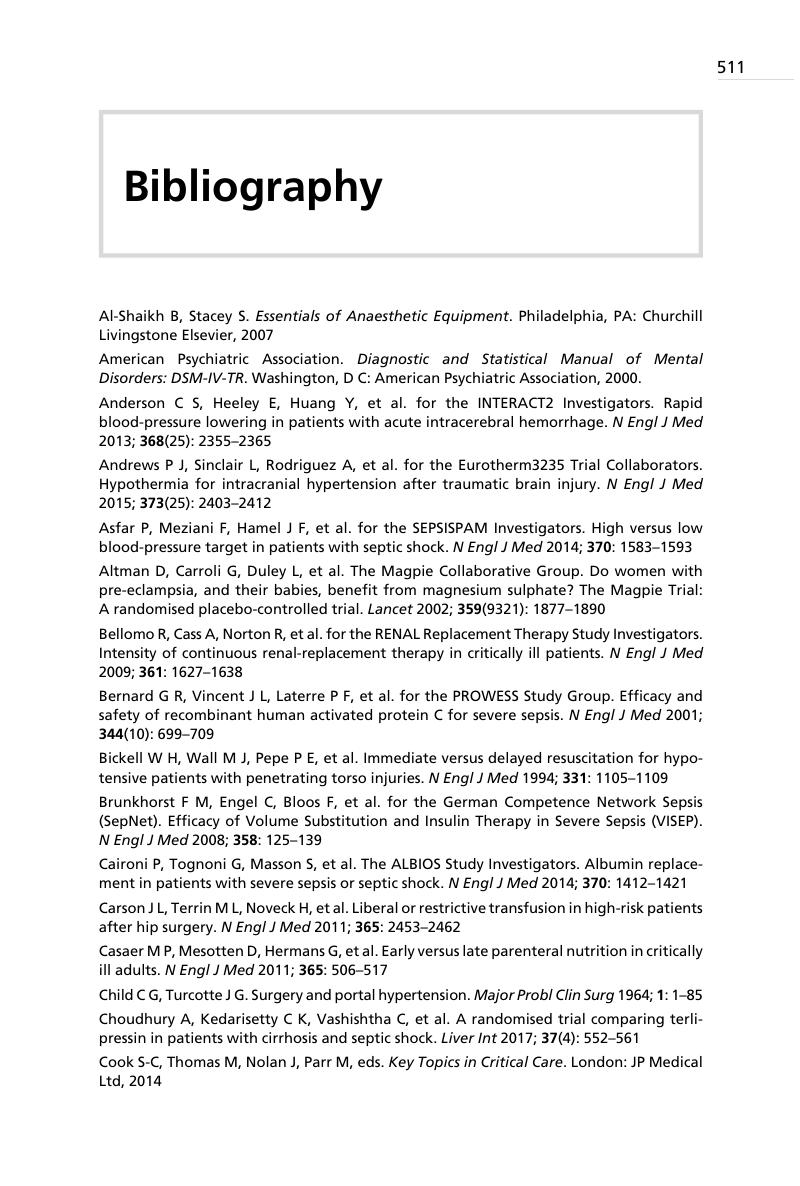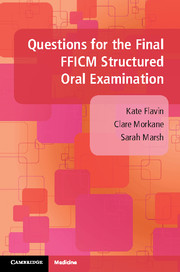Book contents
- Questions for the Final FFICM Structured Oral Examination
- Questions for the Final FFICM Structured Oral Examination
- Copyright page
- Contents
- Foreword
- Preparation for the Viva
- From the Editor
- Acknowledgements
- Abbreviations
- Chapter 1 Abdominal Aortic Aneurysm
- Chapter 2 Abdominal Compartment Syndrome and the Open Abdomen
- Chapter 3 Acute Ischaemic Stroke
- Chapter 4 Acute Kidney Injury and Renal Replacement Therapy
- Chapter 5 Acute Liver Failure and Paracetamol Overdose
- Chapter 6 Acute Respiratory Distress Syndrome
- Chapter 7 Adrenal Insufficiency in the ICU
- Chapter 8 Amniotic Fluid Embolism
- Chapter 9 Anaphylaxis
- Chapter 10 Antibiotic Therapy
- Chapter 11 Antimicrobial Resistance
- Chapter 12 Aortic Dissection
- Chapter 13 Arrhythmias
- Chapter 14 Asthma
- Chapter 15 Bronchopleural Fistulae
- Chapter 16 Burns
- Chapter 17 Calcium
- Chapter 18 Cardiac Output Monitoring
- Chapter 19 Cardiogenic Shock
- Chapter 20 Care of the Heart Beating Organ Donor
- Chapter 21 Chronic Liver Disease in the ICU
- Chapter 22 Chronic Obstructive Pulmonary Disease
- Chapter 23 Colloids
- Chapter 24 Critical Incidents in the ICU
- Chapter 25 Delirium
- Chapter 26 Diabetic Emergencies
- Chapter 27 Diagnosing Brainstem Death
- Chapter 28 Diarrhoea
- Chapter 29 Disorders of Consciousness
- Chapter 30 Donation after Circulatory Death
- Chapter 31 Drowning
- Chapter 32 Encephalitis
- Chapter 33 Fire in the ICU
- Chapter 34 Fungal Infection and Antifungal Therapy
- Chapter 35 Guillian-Barré Syndrome
- Chapter 36 Haematological Malignancy on the ICU
- Chapter 37 Haemoglobinopathies, Coagulopathies and Thrombophilia in the ICU
- Chapter 38 Haemolytic Uraemic Syndrome and Thrombotic Thrombocytopenic Purpura
- Chapter 39 The High-Risk Surgical Patient
- Chapter 40 HIV in Critical Care
- Chapter 41 Hypertension
- Chapter 42 Hyperthermia
- Chapter 43 Hyponatraemia
- Chapter 44 Hypothermia
- Chapter 45 ICU-Acquired Weakness
- Chapter 46 Infective Endocarditis
- Chapter 47 Inflammatory Bowel Disease and ICU
- Chapter 48 Influenza
- Chapter 49 Interstitial Lung Disease and Critical Care
- Chapter 50 Intracerebral Haemorrhage
- Chapter 51 Magnesium
- Chapter 52 Major Incidents
- Chapter 53 Malaria
- Chapter 54 Mental Capacity and Deprivation of Liberty in the ICU
- Chapter 55 Myasthenia Gravis
- Chapter 56 Necrotising Fasciitis
- Chapter 57 Non-Invasive Ventilation
- Chapter 58 Nosocomial Infection and Ventilator-Associated Pneumonia
- Chapter 59 Novel Anticoagulants
- Chapter 60 Nutrition in the ICU
- Chapter 61 Percutaneous Tracheostomy
- Chapter 62 Pharmacokinetics in the Critically Ill Patient
- Chapter 63 Phosphate
- Chapter 64 Plasmapheresis and Plasma Exchange
- Chapter 65 Pleural Effusions
- Chapter 66 Potassium
- Chapter 67 Pre-Eclampsia and HELLP Syndrome
- Chapter 68 Pseudo-Obstruction and Ileus
- Chapter 69 Puerperal Sepsis
- Chapter 70 Pulmonary Haemorrhage and Haemoptysis
- Chapter 71 Pulmonary Hypertension
- Chapter 72 Rehabilitation After ICU
- Chapter 73 Rhabdomyolysis
- Chapter 74 Right Heart Failure
- Chapter 75 Scoring Systems
- Chapter 76 Sedation
- Chapter 77 Sepsis
- Chapter 78 Severe Acute Pancreatitis
- Chapter 79 Spinal Cord Injury
- Chapter 80 Subarachnoid Haemorrhage
- Chapter 81 Tetanus
- Chapter 82 Thyroid Emergencies
- Chapter 83 Toxicology and Overdose
- Chapter 84 Transfusion
- Chapter 85 Trauma
- Chapter 86 Traumatic Brain Injury
- Chapter 87 Tuberculosis
- Chapter 88 Venous Thromboembolism and Heparin-Induced Thrombocytopenia
- Chapter 89 Viral Infection and Antiviral Therapy
- Chapter 90 Weaning from Mechanical Ventilation
- Chapter 91 Withdrawal of Treatment and End-of-Life Care on the ICU
- Bibliography
- Index
- References
Bibliography
Published online by Cambridge University Press: 03 March 2018
- Questions for the Final FFICM Structured Oral Examination
- Questions for the Final FFICM Structured Oral Examination
- Copyright page
- Contents
- Foreword
- Preparation for the Viva
- From the Editor
- Acknowledgements
- Abbreviations
- Chapter 1 Abdominal Aortic Aneurysm
- Chapter 2 Abdominal Compartment Syndrome and the Open Abdomen
- Chapter 3 Acute Ischaemic Stroke
- Chapter 4 Acute Kidney Injury and Renal Replacement Therapy
- Chapter 5 Acute Liver Failure and Paracetamol Overdose
- Chapter 6 Acute Respiratory Distress Syndrome
- Chapter 7 Adrenal Insufficiency in the ICU
- Chapter 8 Amniotic Fluid Embolism
- Chapter 9 Anaphylaxis
- Chapter 10 Antibiotic Therapy
- Chapter 11 Antimicrobial Resistance
- Chapter 12 Aortic Dissection
- Chapter 13 Arrhythmias
- Chapter 14 Asthma
- Chapter 15 Bronchopleural Fistulae
- Chapter 16 Burns
- Chapter 17 Calcium
- Chapter 18 Cardiac Output Monitoring
- Chapter 19 Cardiogenic Shock
- Chapter 20 Care of the Heart Beating Organ Donor
- Chapter 21 Chronic Liver Disease in the ICU
- Chapter 22 Chronic Obstructive Pulmonary Disease
- Chapter 23 Colloids
- Chapter 24 Critical Incidents in the ICU
- Chapter 25 Delirium
- Chapter 26 Diabetic Emergencies
- Chapter 27 Diagnosing Brainstem Death
- Chapter 28 Diarrhoea
- Chapter 29 Disorders of Consciousness
- Chapter 30 Donation after Circulatory Death
- Chapter 31 Drowning
- Chapter 32 Encephalitis
- Chapter 33 Fire in the ICU
- Chapter 34 Fungal Infection and Antifungal Therapy
- Chapter 35 Guillian-Barré Syndrome
- Chapter 36 Haematological Malignancy on the ICU
- Chapter 37 Haemoglobinopathies, Coagulopathies and Thrombophilia in the ICU
- Chapter 38 Haemolytic Uraemic Syndrome and Thrombotic Thrombocytopenic Purpura
- Chapter 39 The High-Risk Surgical Patient
- Chapter 40 HIV in Critical Care
- Chapter 41 Hypertension
- Chapter 42 Hyperthermia
- Chapter 43 Hyponatraemia
- Chapter 44 Hypothermia
- Chapter 45 ICU-Acquired Weakness
- Chapter 46 Infective Endocarditis
- Chapter 47 Inflammatory Bowel Disease and ICU
- Chapter 48 Influenza
- Chapter 49 Interstitial Lung Disease and Critical Care
- Chapter 50 Intracerebral Haemorrhage
- Chapter 51 Magnesium
- Chapter 52 Major Incidents
- Chapter 53 Malaria
- Chapter 54 Mental Capacity and Deprivation of Liberty in the ICU
- Chapter 55 Myasthenia Gravis
- Chapter 56 Necrotising Fasciitis
- Chapter 57 Non-Invasive Ventilation
- Chapter 58 Nosocomial Infection and Ventilator-Associated Pneumonia
- Chapter 59 Novel Anticoagulants
- Chapter 60 Nutrition in the ICU
- Chapter 61 Percutaneous Tracheostomy
- Chapter 62 Pharmacokinetics in the Critically Ill Patient
- Chapter 63 Phosphate
- Chapter 64 Plasmapheresis and Plasma Exchange
- Chapter 65 Pleural Effusions
- Chapter 66 Potassium
- Chapter 67 Pre-Eclampsia and HELLP Syndrome
- Chapter 68 Pseudo-Obstruction and Ileus
- Chapter 69 Puerperal Sepsis
- Chapter 70 Pulmonary Haemorrhage and Haemoptysis
- Chapter 71 Pulmonary Hypertension
- Chapter 72 Rehabilitation After ICU
- Chapter 73 Rhabdomyolysis
- Chapter 74 Right Heart Failure
- Chapter 75 Scoring Systems
- Chapter 76 Sedation
- Chapter 77 Sepsis
- Chapter 78 Severe Acute Pancreatitis
- Chapter 79 Spinal Cord Injury
- Chapter 80 Subarachnoid Haemorrhage
- Chapter 81 Tetanus
- Chapter 82 Thyroid Emergencies
- Chapter 83 Toxicology and Overdose
- Chapter 84 Transfusion
- Chapter 85 Trauma
- Chapter 86 Traumatic Brain Injury
- Chapter 87 Tuberculosis
- Chapter 88 Venous Thromboembolism and Heparin-Induced Thrombocytopenia
- Chapter 89 Viral Infection and Antiviral Therapy
- Chapter 90 Weaning from Mechanical Ventilation
- Chapter 91 Withdrawal of Treatment and End-of-Life Care on the ICU
- Bibliography
- Index
- References
Summary

- Type
- Chapter
- Information
- Questions for the Final FFICM Structured Oral Examination , pp. 511 - 515Publisher: Cambridge University PressPrint publication year: 2018



